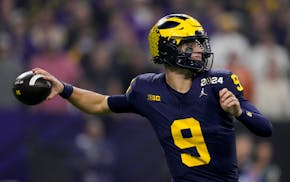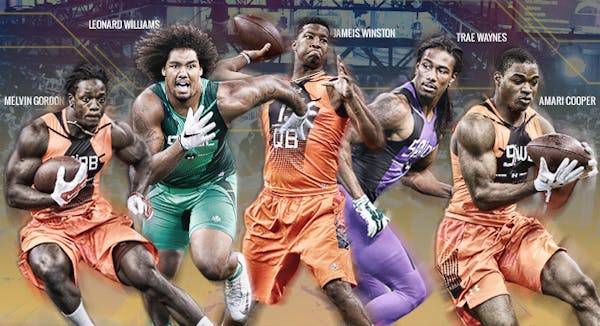It's time for the NFL draft, and so time for a sentence that has never been typed or uttered, ever, even by those who love him most, and perhaps especially by those who love him most:
Entertain us, Rick Spielman.
As far as we know, Spielman's idea of a party is a six-pack of Red Bull and the director's cut of the 1987 NFL combine. Draft week is his version of "The Hangover," with LSU Tigers and "Mike" linebackers replacing actual tigers and Mike Tyson.
The Vikings general manager stands so upright you wonder if his spine has been replaced by a goalpost. He starts an alarming number of sentences with the word "again," as if he's rehearsed every possible answer to every possible question so frequently that he feels like he's uttering the same sentence for the 300th time.
Here's what's strange about the convergence of obsessive-compulsive evaluators such as Spielman and an annual draft that promises to disappoint about of a third of its viewers on draft night and another third sometime in the next three years:
Somehow, this has become great entertainment. And with Spielman in place, the Vikings are as likely as any team to create intrigue.
Spielman is not an entertainer, but he is bound to make two or three fascinating moves during this draft. Last year, it was taking Anthony Barr, a former running back learning how to play linebacker, with the ninth pick, and trading up to grab quarterback Teddy Bridgewater at the end of the first round.
So the Thursday of last year's draft turned out to be the most interesting and important day of the entire year for the Vikings. Spielman standing at a lectern talking about players of unknown quality wound up being far more important than the Vikings' annual trip to Lambeau Field, and would have been even if Christian Ponder hadn't taken that opportunity to bid farewell to NFL playing surfaces.
The modern sports fan is accustomed to every moment of every day for every team winding up on video. It wasn't always thus.
Twenty or thirty years ago, there were no draft parties. There was no expanded television coverage. There weren't draft analysts on television. If you wanted to read prospect analysis on sleepers and potential busts, you ordered a pamphlet from a guy named Joel Buchsbaum.
A pamphlet. It arrived in the mail. Not e-mail. Actual mail. Mel Kiper Jr. was a mere follicle.
The Vikings would make their picks, and then Jerry Reichow and Frank Gilliam, two wonderful guys who ran the draft for the team, would mosey down to the basement to talk. Awaiting them were a few reporters and a bag of chips.
Reichow and Gilliam sat behind the kind of table made famous by parent-teacher conferences. There were folding chairs and a lot of shrugs that were translated to mean: "Yeah, this kid might be able to play."
They didn't begin sentences with the word "again" because they hadn't answered many questions, real or imagined, about anything.
The rise of the draft's popularity has been stunning and is now complete. You need not order a pamphlet to gain draft insight — open your door in the morning and there will be a self-proclaimed draft expert screaming his Mock Draft 38.9 at you.
This year, the draft is beginning its national tour, and leaving New York. It will be held in Chicago this week, and will soon be a carrot offered by the league to cities willing to take on a franchise or build a new stadium.
A couple of decades ago, the NFL draft wasn't a centerpiece or bargaining chip, it was a necessary procedure, such as root canal.
This weekend, Spielman will stand at a lectern talking about his draft picks and trades, about 22-year-olds who might be worthwhile and might not, and NFL fans will watch as raptly as Tarantino fans wondering how, in "Pulp Fiction," Christopher Walken got that gold watch home.
Jim Souhan's podcast can be heard at souhanunfiltered.com. On Twitter: @SouhanStrib. jsouhan@startribune.com

Souhan: Wolves fans made Game 1 special. Now bring on Game 2.

Souhan: Should Vikings even consider McCarthy in NFL draft?

Souhan: NAW erases Suns' lead, Game 1 advantage with big performance

Souhan: This is KAT's chance to prove Flip Saunders was right


